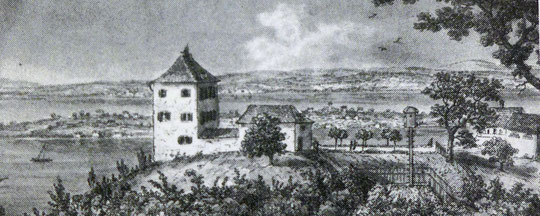Culture
Sandegg Castle
Practice day in Napoleon history - the reconstruction of Sandegg Castle is part of this vision
A vision of the author of Regions-Europas.work on history and culture. The vision was formulated in December 2018.
|
A student is in a school in the northern part of Switzerland. We are counting the year 2027. The history lesson is about Napoleon Bonaparte. We have finished the examination
discussion. Now the teacher says there will be a practice day in Napoleon's history next week. On Tuesday of the following week we visit the historical sites of Napoleon's
descendants.
On that day we take a bus to Waeldi in the canton of Thurgau to the Napoleon Tower. Then to the Napoleon Museum, which is housed in the castle Arenen Berg in Salenstein. We hear a lot about Napoleon's history from the tour guide. Afterwards we hike past the training facilities of the estate to Lake Constance. Now we go up the mountain in a forest path to Sandegg Castle. Sandegg Castle was recently rebuilt. The building has modern large windows, the shape and size correspond to the drawings from 1830. On the upper floor there is a hall where we eat rabbit meat, polenta and beans. From here we can enjoy the view over Lake Constance and the island of Reichenau, just as the abbot has done in the 1000-year history of Sandegg Castle. In the rooms next door there are many cardboard models of castles. A cardboard model costs Fr. 5. The cardboard models of the Napoleon Tower, the castles Arenen Berg, Sandegg and Eugens Berg together with a black and white portrait of the current owner of the property are available for a good price. I buy the whole package. Then we look at the tower outbuilding from the outside. Those interested in technology can inform themselves about the functionality of the solar system with battery storage and inverter. We go on to the listed buildings with ancient gardens. Now we walk in the direction of Eugens Berg. We see giant rabbits. There are said to be more than 800 of these giant rabbits on the estate. Then we see corn fields and bean plantations, also shrubs with berries and an apple plantation with small trees. Arrived at the castle Eugens Berg we visit the rooms from the history of the Eugène de Beauharnais, a person of the Napoleon family. Now we drive in our bus back to the school of our community and to home. The practice day of Napoleon's history will be remembered for a long time. |
| The original text is written in ∗ German. This is a translation |
|
Legend:
∗ With one click you get to the corresponding website. - Introduction Graphic from napoleonturm-hohenrain.ch |
| Last update: April 9, 2025 |
The above story is from Regions-Europe.work
The history of Sandegg Castle
Sandegg Castle was located in the municipality of Salenstein in the district of Kreuzlingen in the canton of Thurgau in Switzerland.
According to sources from the 15th century, an Alemanne named Sintlaz lived at Sandegg Castle as early as the 8th century. Sandegg Castle has been documented in the possession of the Reichenau Monastery since the middle of the 13th century. After 1272 the castle was the preferred residence of Abbot Albrecht, whose monastery was still in ruins after the fire of 1235. From 1350 the impoverished monastery had to pawn Sandegg Castle, it began a period of constant change of ownership. In 1671 it was bought by the Jesuits of Constance and in 1693 by the monastery of Muri in the canton of Aargau. Its abbot Plazidus Zurlauben converted the castle into beautiful complex. At the beginning of the 19th century, the castle was again dilapidated and was finally bought by Zurich banker Konrad Hottinger, who thoroughly renovated it. When the oven of the castle was heated to dry the new paints, the building burned down completely on September 3, 1833.
The ruin could not be entered since 2005, because there was a danger of collapse. The northwest corner of the ruin crashed in autumn 2006. The current status of the construction work is unclear. In the meantime it is probably possible to enter the ruin again today in December 2018.
The history of Sandegg Castle
Sandegg Castle was located in the municipality of Salenstein in the district of Kreuzlingen in the canton of Thurgau in Switzerland.
According to sources from the 15th century, an Alemanne named Sintlaz lived at Sandegg Castle as early as the 8th century. Sandegg Castle has been documented in the possession of the Reichenau Monastery since the middle of the 13th century. After 1272 the castle was the preferred residence of Abbot Albrecht, whose monastery was still in ruins after the fire of 1235. From 1350 the impoverished monastery had to pawn Sandegg Castle, it began a period of constant change of ownership. In 1671 it was bought by the Jesuits of Constance and in 1693 by the monastery of Muri in the canton of Aargau. Its abbot Plazidus Zurlauben converted the castle into beautiful complex. At the beginning of the 19th century, the castle was again dilapidated and was finally bought by Zurich banker Konrad Hottinger, who thoroughly renovated it. When the oven of the castle was heated to dry the new paints, the building burned down completely on September 3, 1833.
The ruin could not be entered since 2005, because there was a danger of collapse. The northwest corner of the ruin crashed in autumn 2006. The current status of the construction work is unclear. In the meantime it is probably possible to enter the ruin again today in December 2018.
